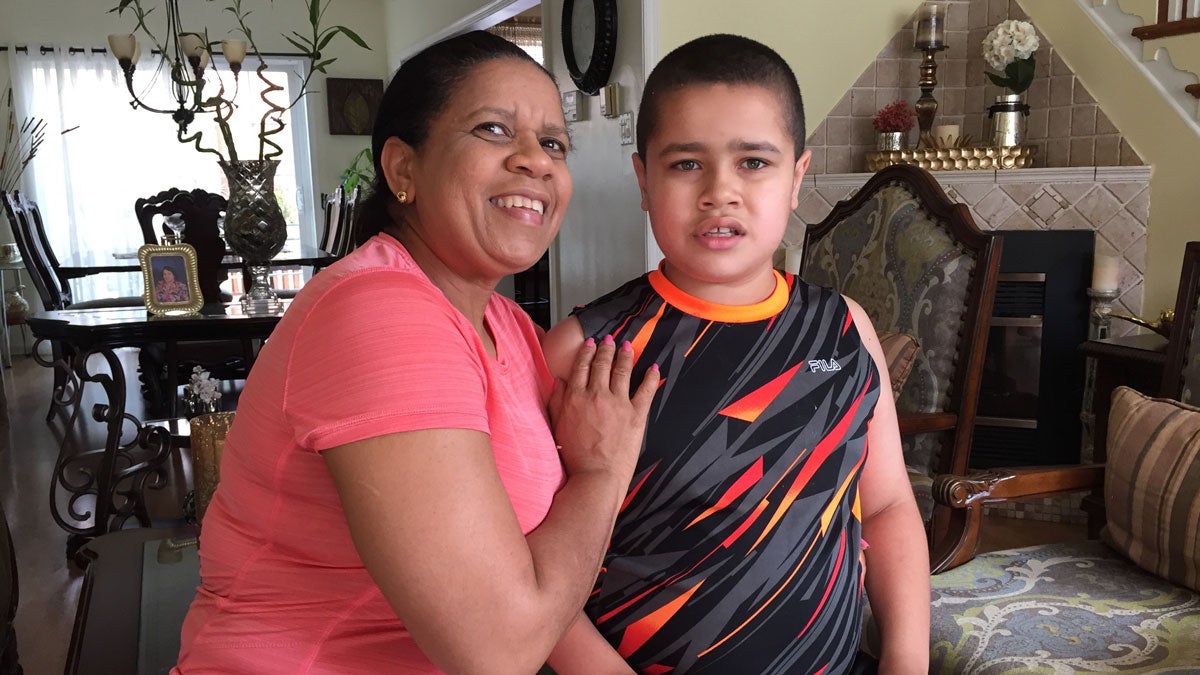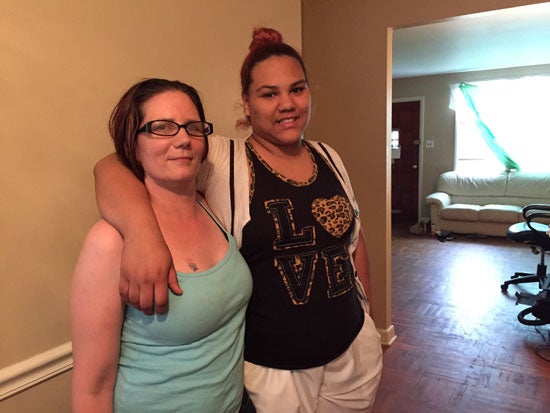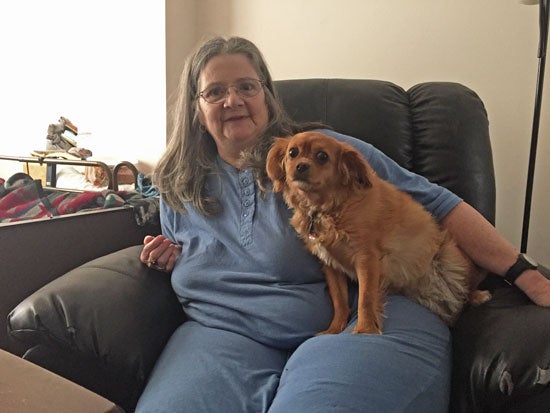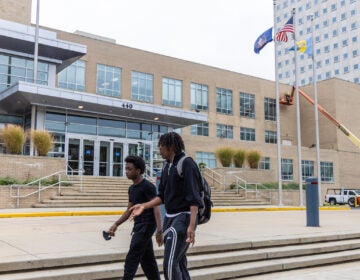Segregated and satisfied: parents of special ed students blanch at calls for inclusion
Listen 6:32
Francisca Castelli and her son, James. James was a student at Wordsworth Academy in Fort Washington, Pennsylvania.
While advocates call for major changes, some special education parents demand their children stay in specialized private schools.
Thirteen is a tricky age for many kids. But for Kayla Hinton, the past year has been downright hellish.
In November, a man shot and killed one of her closest friends just steps from her home in Philadelphia’s Kensington neighborhood. In May, her father died suddenly from a heart attack. In between, she’s endured multiple hospital stays and wrestled with suicidal thoughts.
“Right now, my daughter is lost,” said her mother, Katherine Artuso.
Kayla is no stranger to setbacks.
She suffers from attention deficit hyperactivity disorder and disruptive mood dysregulation disorder. In school she struggles to focus and follow directions. When she was younger she would spring out of her seat spontaneously and walk around class. Sometimes she’d lash out and leave the room altogether.
“People would look at me some type of way, like I was a creature or something,” Kayla said.
Since moving to Philadelphia in 2013, Kayla went to three different public schools. Each was supposed to be a better fit for students like her — students who need what’s known as emotional support. Many emotional support students, like Kayla, live with a toxic brew of life trauma and mental instability. So far, her family says, none of the district’s remedies has worked.
Artuso wants Kayla to attend a special private school for students with emotional disabilities “because of the simple fact the school district has let me down multiple of times already.”
Artuso isn’t alone.

The School District of Philadelphia spends about $76 million annually to pay for roughly 1,500 special education students to attend private schools geared toward their specific needs. These children are some of the city’s most vulnerable, their schooling histories dotted with failed interventions and wasted years.
Within the last month, about 100 of these students became educational orphans when the district opted to end a contract with Wordsworth, one of the specialized or “approved” private schools serving Philadelphia children.
This seemingly innocuous decision set off a debate over how to educate kids like Kayla, a debate that drives at broader issues than the fate of 100 children.
Special education advocates say the students should be reintegrated into public schools as thoroughly and quickly as possible. They argue sending kids to Wordsworth and similar facilities constitutes a form of segregation because it sequesters needy kids in sheltered schools.
“Setting up these programs in buildings with general education student population with maximum opportunity for inclusion should not be aspirational, it should be required,” said Gabe LaBella, staff attorney at Disability Rights Pennsylvania, at a July meeting of the School Reform Commission.
This logic, however, worries many of the families it’s designed to help.
“Inclusion is fine, but it’s not for everybody,” said Deborah Colter, whose 16-year-old daughter Aniyah has been at Wordsworth since eighth grade. “You want it to work. But all that glitters is not gold.”
The mere proposition of sending their kids to a public school enrages parents like Colter. Many say their children only began to flourish when they were separated from general education students and surrounded exclusively by teachers trained to handle their precise needs. Why would they abandon something that works? Just because a batch of experts prefer it?
“It sounds good on paper to put them in a less restrictive environment,” said Kimberly Black, who son, Quentin, has attended Wordsworth the past three years. “But there’s just certain students with behaviors that need to be segregated.”
What follows is a story about precisely that: integration and segregation. But in this case, those who’ve been segregated are the ones trying to keep it that way.
“This put me out of control”
When Francisca Castelli first heard earlier this month that her nine-year-old son James may have to leave Wordsworth Academy day school in Fort Washington, Pennsylvania, she went into shock.
“This put me out of control,” said Castelli, an immigrant from the Dominican Republic who lives in lower Northeast Philadelphia.
James has been at Wordsworth since he was five. It’s the only school Castelli trusts to educate her only son, who suffers from autism and a chromosomal disorder called microdeletion.
“He know the people there. He know the teachers. And he feel comfortable,” she said.
James struggles to speak and he’s prone to outbursts. She’s absolutely sure her son needs the support provided by a school like Wordsworth.
“Me and his dad, James’ dad, we feel comfortable. We feel peace of mind with him at Wordsworth,” Castelli said.
Her peace of mind evaporated when the district decided to end its contract with Wordsworth, though the district’s decision had merit.
In October, a 17-year-old student at one of Wordsworth’s other alternative schools died after scuffling with a staffer. A subsequent investigation by Philly.com uncovered years of abuse and maltreatment at the same facility, which is located in Philadelphia. Wordsworth later filed for Chapter 11 bankruptcy and was absorbed by a nonprofit conglomerate called PHMC.
Amid the turmoil, district officials proposed ending the relationship with Wordsworth and opening a new school.
Originally the plan was to create a 600-student program primarily for emotionally disturbed students. The program would be managed by an outside provider, Catapult Learning, but housed inside public school buildings and overseen directly by the district.
Advocates railed against the plan. They saw the new initiative as a reconstituted form of approved private school and worried it would encourage the district to shuttle more special education students into segregated settings.
The district then scaled back its proposal. On July 6, it approved a program to serve 100 students, focused primarily on students who were at the Wordsworth Academy day school in Fort Washington. The plan is for Catapult to run the program initially, but eventually hand the program off to school district teachers and administrators. It will be housed at three district schools.
Still, many advocates weren’t satisfied. They wanted the district to use Wordsworth’s troubles as an opportunity to reintegrate children currently at private schools. A coalition of special education organizations wrote the School Reform Commission a letter opposing the plan.
“Inclusion does not mean a separate setting within the school district,” said Maura McInerney, an attorney at the Education Law Center. “It means placing students with disabilities in general education classes, but incorporating fundamental changes in the way school communities support students.”
The idea of inclusion is baked into the federal law governing special education. That law, known colloquially as IDEA, calls for special education students to be placed in the least restrictive environment possible. That means, generally, districts should err on the side of serving special needs students in general education classroom settings.
School officials in Philadelphia say they’re embracing that philosophy more than ever, pushing to bring students back from private placements and into district buildings. In the last two years they’ve started in-house programs for hearing- and vision-impaired students.
“We realize that we can do a really great job with our students and we want to provide ourselves with more opportunities for our students to choose these options,” said Cheryl Logan, the district’s chief academic officer.
Years of research shows special education students can benefit academically when they’re exposed to general education peers. Plus, many argue, special education students won’t go through their adult life sheltered. Why, then, should their education be sheltered?
“We’re saying all children deserve some integration with their non-disabled peers,” said SRC member Estelle Richman. “You’re not going to live your life after school in a world that is entirely segregated.”
Richman compares the district’s shift away from private schools to the decades-long trend of closing state-run hospitals for the mentally ill. Both, she said, stem from a desire to broaden the exposure and life experiences of historically excluded populations.
Special education data shows emotionally disturbed students are among the most likely to spend time outside general education classrooms. Nationwide just under 13 percent of students with emotional disturbance attend a separate school for students with disabilities. Only students with multiple disabilities and students with combined deaf-blindness are more likely to be in a separate school.
In other words, among students with a single disability, emotionally disturbed children are the least likely to be at a school with general education peers.
There may, however, be legitimate reasons for that level of separation. Studies show it can be especially difficult to integrate students who need emotional support, with some academics arguing that separated settings make most sense for emotional support students. Plus, some research suggests, the presence of emotionally disturbed children in general education classrooms can harm their non-disabled classmates.
“I have kids that are legitimately dangerous. They are dangerous to themselves. They’re dangerous to other kids,” said Daniel Cooper, a special education attorney with multiple clients at Wordsworth.
“You want to integrate that child, but you can’t,” he said.
Cooper likes the idea of inclusion in theory, but believes it can get messy in practice. Many of his clients spent years watching their kids flounder in public schools. They don’t trust the school system and they don’t believe an integrated classroom model can work for their kids.
“They’re not segregated because no one wants them,” Cooper said. “They’re segregated because they’re somewhere where they need to be to make progress.”
Advocates, however, say the problem isn’t inclusion as a concept, but rather the district’s past failures. With more money and better planning, they say, students with emotional disabilities could be better integrated into neighborhood schools. If parents are reticent it’s the byproduct of poor execution on the district’s part they say.
“The reality is that many families of children with disabilities in the district are forced to choose between a highly-segregated setting that offers their child needed supports, and a neighborhood school that lacks essential resources and interventions to support their child,” said McInerney of the Education Law Center.
“For these families, it is difficult to envision what they have not yet seen.”
Richman understands parents’ apprehension. It makes perfect sense, she said, to distrust a district that has failed their children before.
“They have a right to be fearful,” she said. “I don’t think we’ve shown we can do it yet. No parent wants their child to be an experiment.”
And that’s exactly how Kimberly Black feels.
“It’s a new program. There’s gonna be growing pains. I don’t want him to experience their growing pains,” Black says of her son, Quentin.
“He’s gonna be like a test pilot and he’s not the type of kid to be a test pilot. He thrives with structure and routine and that’s what he gets at Wordsworth.”
Since Quentin was in second grade Black has battled with the school district to find better programming, she said.
At first Quentin was placed in an autism support classroom at Louis Farrell Elementary, she said, but her son didn’t fit there. Many of his classmates, while also autistic, were non-verbal or severely intellectually impaired. Quentin, meanwhile, is relatively high-functioning for a student with autism.
The district then moved him to Thomas Holme School, where staff struggled to contain his outbursts, Black said.
“He would become very violent and he would tear apart the classroom and they would have to usher the other students out,” Black recalled.
During one episode, she says, Quentin drove his hand through a glass window in the principal’s office.
Since coming to Wordsworth, however, Quentin has learned to moderate his violent impulses. She calls the school “a find.”
“They have made such a difference in him,” Black said. “He’s no longer physically aggressive. He’s verbally aggressive, but no longer physical.”
Given Quentin’s history, Black recoils at the idea of sending him back to a public setting. Even if the new program merely lives inside a public school, Black is wary. Intermingling with general education students before school or in hallways could cause flare ups, she said.
“He’s not coming back here,” Blacks said. “He needs to be at an approved private school.”

Harriett Glassey also worries her grandson, Charles Cain, will fall back into old and dangerous habits if he’s put in a district school
“The worst case scenario is he would be put into a regular school,” Glassey said. “If he’s put in a regular school he’s gonna start up again with the fights and the arguments and he’s not gonna learn anything. Hell, he’s gonna graduate school knowing nothing.”
The parents interviewed for this story paint a strikingly similar picture, one of traumatic setbacks and repeated disappointments. All said their children are multiple grade levels behind in math and reading.
Many have modest goals for their children. Glassey hopes her grandson, Charles, can attend a vocational school after turning 21. Kimberly Black believes with the right help, Quentin can realize his dream of painting cars.
Most relevant here, all the parents doubted the district’s ability to guide their students through what are unquestionably treacherous educational voyages.
Alisha Rodowsky is at least open to the idea of her son, Elijah, someday attending classes with general education students. She worries, though, about the timing. Elijah is entering seventh grade, and she can’t picture him thriving in a neighborhood middle school. There’s already so much change and turmoil during those grades, even for students without disabilities.
A setting like Wordsworth, she thinks, would be preferable right now.
“Some people can quit cold turkey. Some people can’t,” she said. “I don’t want to just pull him out and have him totally regress. That’s the fear I have.”
The district cannot simply ignore these parents’ concerns. All of their children have Individualized Education Programs (IEPs) that state they should be in an approved private school.
This means the district has a difficult needle to thread. As much as they want to encourage inclusion, they’re bound by law — and some sense of sympathy — to negotiate with families.
“We can’t just say we’re going to integrate,” said Cheryl Logan. “They’re in a separate placement because that’s what their IEPs call for.”
If Francisca Castelli has her way, James’ IEP will never call for him to attend a public school. She’s firm on this. When presented with the idea of James enrolling in a district-run program her voice rises a register.
“No public school anymore,” she said. “He gonna be in private school. He needs to be in a private school.”
Castelli would prefer to have her son in the care of family rather than in the care of the Philadelphia public schools. She couldn’t legally do that if James remained in the states, and so she’s already devised a backup plan: sending him to live with relatives in the Dominican Republic.
“I’m gonna send him back to my country [so] that my family take care of him,” she said. “Just, I’m trying to protect my son. Trust me.”
WHYY is your source for fact-based, in-depth journalism and information. As a nonprofit organization, we rely on financial support from readers like you. Please give today.





